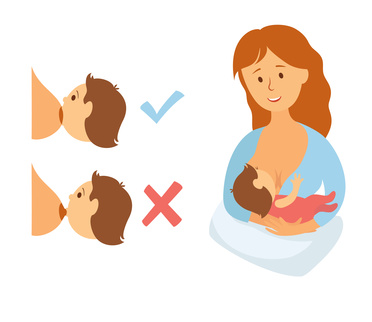Baby Positioning and Latch On
Positioning is everything when breastfeeding. It’s important for you to take the time to get comfortable and find the right position. If you or your baby aren’t comfortable, your baby may have issues latching on. If your baby doesn’t latch on correctly, you will encounter problems when nursing and your breastfeeding sessions will not last long.
Positioning
Cradle Hold: The cradle position is rather self-explanatory: Your baby lies in the crook of your arm, which you use to move her around to get close to your breast. Sit up with plenty of support for your back. You can also place a pillow in your lap underneath the baby to lessen the strain on your cradling arm. This position is great for helping your baby learn to properly latch on each time they nurse.
Football Hold: Before you get started, you’ll need at least two pillows. Place one pillow on your lap and the other pillow to the side of you. Put the baby on your lap with his legs pointing toward your back, keeping your hand under his head and back for support. Make sure his mouth is level with your nipple before you begin. This is a great position for nursing twins because you can feed two simultaneously. It’s also good after cesarean delivery since it keeps pressure off your abdomen.
Lying Down: Begin by lying next to baby on the side you want to nurse on. Turn baby to face you, making sure his mouth is level with your nipple while you support his head and back with your free arm. This is a great nursing position for women recovering from a cesarean birth.
Latching On
First, bring baby’s head up to your breast, check to see that your baby is facing straight toward you and that the head, chest, and abdomen are all aligned. Using the opposite hand, take one of your breasts and tickle baby’s lips lightly with your nipple. Stroking the baby’s lips with the nipple stimulates the rooting reflex, your baby will likely open wide to get the breast in their mouth. Use your other arm to cradle baby and support the baby’s head. Once baby’s mouth is open, quickly bring baby towards the breast. Your baby’s instinct will tell them to latch on and begin nursing. Avoid the urge to lean closer to baby to get the breast in their mouth. It’s tempting to go to baby, rather than bring baby to you, but it causes you to hunch over, which could lead to back strain.
When a baby is properly latched on the areola (dark area around the nipple) will be compressed and providing the baby with milk. Your nipple should be in the back of the baby’s mouth when nursing in order for baby to be latched on correctly and activate milk release. The correct latch will be fairly tight, and you can check correct positioning by looking to see whether most of the areola is in baby’s mouth. If nursing hurts, chances are your baby is latching on to the nipple. This is a sign to remove the baby and reposition. Gently insert your pinkie finger into your baby’s mouth to break his grip on the breast and begin again.
Ameda Expert Advice– Empowering moms with information about breastfeeding, pumping, milk production and more to ensure success throughout their breastfeeding journey.

Breastfeeding Techniques
Get My Insurance Covered Pump
Complete our online form and we'll take care of the rest!
